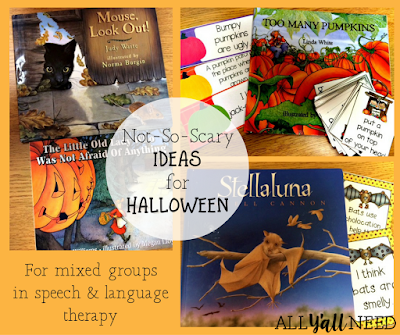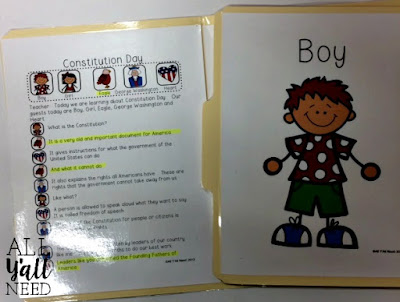Speech/language therapy rooms are often small. Mine is about 10 x 10. With a school population of 700+ and a licensed assistant, it's a challenge to make room for appropriate materials for a varied caseload
and two adults. Here is my start to the year, and the room took less than two hours to set up! Keep reading for my 6 top tips for setting up a therapy room in a small space to make it efficient, fun, and most importantly, student-centered.
Here is where I started, otherwise known as the obligatory "before" pictures.
1. Label packing boxes by location
Start by unpacking well. Actually, it starts with packing well when the school year ends. It's tempting to throw everything into boxes at the end of the year - resist the urge. You'll regret it. Pack by room location instead. Here, my boxes were labeled "top of desk", "top shelf books", "middle shelf books", and "bottom shelf books".
A few years ago, my librarian sister arranged my top two bookshelves alphabetically by author's name. The third one is by season, starting with winter. When I looked at the boxes, I didn't have to think about what was in the box or look at author's names and remember which shelf they went on. I just had to pull out the books and shelve. It saved soooo much time! Labeling the location of where to put things helps so much more than labeling what the items were. I lose time when I read "mirrors" and have to think, "Where do I keep those?" If they are labeled "metal cabinet, second shelf", I can just unpack and put up.
If you are inheriting someone else's room, it will take time to go through everything. Keep reading for tips on how to make your room efficient, and then you can start the packing tip in May or June.
2. Make the room student-centered
The students are the focus of my work, and I want to make sure that is reflected in the room, no matter how small it is. My kidney table is in the middle of the room. My desk and storage are along the wall edges. The first visible items to the kids are the table and stools. That sets up the message that upon entering, we are going to get to work. The majority of the room is for them.
Like the stools? My wonderful husband painted them!
3. Know where the plugs are
The first year I was in the room, it was a sudden move, and I didn't have time to plan. My desk was in one corner, the phone was in another corner, and it was a mess. Make sure you set up the computer and printer near those plugs. It sounds so basic, but after doing it wrong, I'm conscious of the plugs now.
Even now, I'm moving my hole punch and pencil sharpener. They are sitting on the bookshelf, and there is a plug there. I just forgot to plug them in
before I loaded up the shelves with the books.
4. Set up materials by priority
Keep items that you use every day close by. You should need no more than 1-2 reaches to get to those materials. Examples are pens, dice, game markers, therapy cards, etc. Think of things that you use no matter what the season.
On this organizer behind the therapy table, there are containers that hold all of those things. "One reach" means I don't have to move from the chair. I can just reach for a pen and not waste time. "Two reach" is open a container and reach in. That would be the crayons, for example. I don't have them out in the open, but I can just pull out the drawer.
Weekly materials go on the edges of the kidney table. Once therapy starts, the materials I use for the week will be "one reach".
Prioritize the rest of the materials by 3 or 4 or even 5 reaches. The metal cabinet serves that purpose.
I have to get up (such a first-world problem) for reach 3, open the doors for reach 4, and then find what I need for reach 5.
Here, the Easter eggs are in the middle container. I only use them for a short time in the spring, so they don't have to be highly visible. In the spring, I'll pull out the Easter eggs, put them near the therapy table, then put them back up once I'm done.
Therapy cards are in a shoe holder with labels. It's easy to get up, grab what I need, and go back to the therapy table. I need them to be more visible, hence the clear pockets.
5. Be kind to the custodians
Every year, I pack up the room so the custodians can move everything out and clean it. When I returned this year, the custodians had already set up my furniture in the right locations. That was a huge timesaver. Being thankful and considerate of the custodians can pay off big time. Each one stopped by to say hello, and I was sure to thank them for cleaning the room and putting everything back. Make friends with the custodians. If you notice what they do for you, they'll have your back.
6. Reward yourself!
You've worked hard. Give yourself a treat!
Small therapy rooms can be fun, efficient, and student-centered. Make sure yours is!






























































